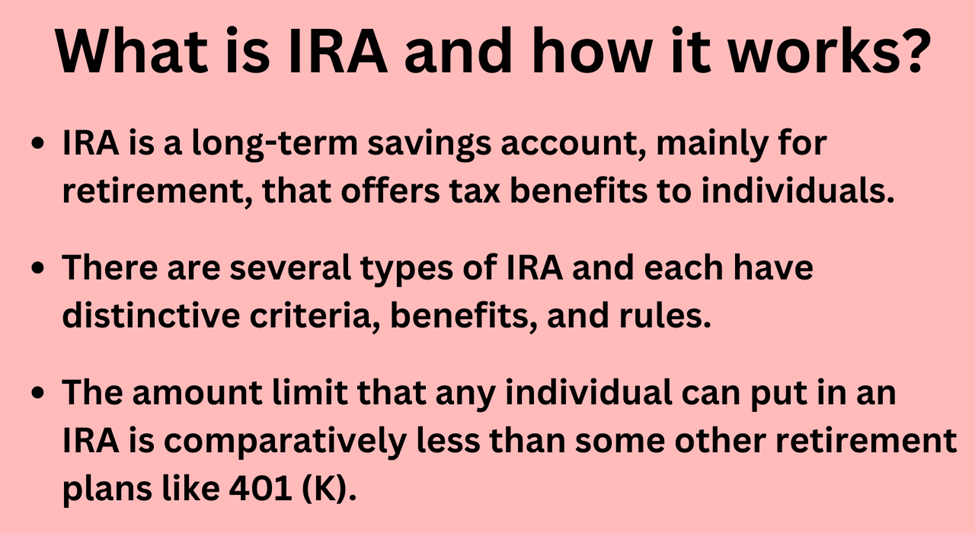
Retirement planning is one of the crucial as well as confusing parts of financial planning for any individual. Several things should be considered before individuals plan their retirement, and it is advisable to start retirement planning at an early stage of life.
While there are plenty of options to do savings and enjoy after retirement, each has its advantages and disadvantages.
Today, we would discuss individual retirement accounts (IRA), their types, and their pros and cons:
What is Individual Retirement Account or IRA and how it works?
What is an IRA account in USA? An IRA can be referred to as a long-term savings account that offers certain tax benefits to the holders. The earning individuals generally open IRAs to save and get tax benefits, which could help them in their latter period of life.
The IRA could be opened by any individual with earned income, even who couldn’t have access to an employer-only provided benefit, 401 (K). The individuals can open IRAs through any institution, including banks, investment firms, brokerage companies, etc., that are approved by the Internal Revenue Service or IRS to provide these services.
As said earlier, any earning individual can open IRAs, but there are limitations on the annual amount of total contributions in these accounts. While opening an IRA, the individual can opt for several investments in different financial assets like stocks, bonds, ETFs, etc.
There are primarily four types of IRAs, which includes traditional IRAs, Roth IRAs, Simplified Employee Pension or SEP IRAs, and Savings Incentive Match Plan for Employees or SIMPLE IRAs.
Each has its requirements, rules, eligibility, benefits, etc. The first two types can be opened by individual taxpayers while the latter two are for small business owners and self-employed people.
In a traditional IRA, the individual could contribute with tax deduction benefits, meaning if you put a certain amount into that account, that amount would be deducted from your taxable income for the year. The individual can withdraw the amount during retirement, and it would be then taxed at the normal tax rate. This mainly helps the individual in growing their money in a tax-deferred manner.
Roth IRAs are not tax deductibles, but qualified distributions are tax-free in this case. The individual must pay tax on the amount they are putting in, but no tax should be paid on the investment gains. The tax rules in SEP IRA and SIMPLE IRA are the same as traditional IRAs.
 Source: ©Kalkine Media®; © Canva via Canva.com
Source: ©Kalkine Media®; © Canva via Canva.com
Advantages:
As mentioned earlier, it provides a tax benefit while any individual is saving for the retirement. Depending on the IRA type, the IRA could help the person in reducing their current tax bill either now when they put their money or at retirement. Notably, all the gains from investments are generally tax-free.
In addition, the IRAs are insured by a government-led agency, Federal Deposit Insurance Corp or FDIC, which provides an assurance, and it covers the deposits of the holders of up to US$ 250,000 in the majority of cases. However, to have that coverage, one should open their IRAs in a bank or institution that is insured by the FDIC.
In simplest terms, IRAs provide the opportunities to grow assets on a tax-free basis, which means, an individual does not have to pay any tax on dividends or any kind of gains from the investments until it is withdrawn.
Drawbacks:
As every path has its puddle, there are certain limitations and regulations that individuals should also consider before opening an IRA. For instance, as IRAs are specifically for retirements, there is generally a 10 per cent penalty on early withdrawal, if any individual takes their money out before 59 and half years of age.
However, there are some exceptions like a health emergency, educational expenses, death, etc.
Secondly, the amount that can be contributed to an IRA is too low compared to many other retirement plans like 401 (K). In 2022, an individual can put as much as US$ 20,500 per year in the latter plan, while in the former plan, only up to US$ 6,000 can be contributed. However, if the individual is aged over 50, he could contribute as much as US$ 7,000.
In addition, if any individual has any other retirement plans, then the amount kept in IRA might not get fully deducted from the tax. For instance, in 2021, any single or head of the household could have a full deduction, only when their MAGI or modified adjusted gross income is below US$ 66,000 a year. For married individuals filing jointly, the max limit of MAGI was US$ 105,000.
Bottom line:
While IRA is one of the most popular retirement plans helping individuals to grow their assets on a tax-free basis, it is important to know all the regulations. For instance, traditional IRAs require RMD or required minimum distributions, meaning after any individual reaches the age of 72, they must start withdrawing a minimum amount each year.
So, while planning your retirement and considering including IRA in it, the individual should exercise due diligence before opening the account.






